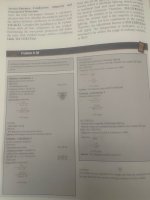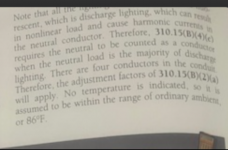Jpflex
Electrician big leagues
- Location
- Victorville
- Occupation
- Electrician commercial and residential
I’m trying to understand what is wrong here
Assuming we did a load calculation for a commercial variety store and were trying to calculate service wire size for a 3 phase 4 wire (neutral) 208 volts system, ambient temperature standard 30 degrees Celsius we have:
48,120 VA noncontinuous loads
36,200 VA continuous load
Neutral load 47,602 VA
1. Calculate continuous load 36,200 x 125% = 45,200 VA
2. For total ungrounded conductor load, add continuous load plus non continuous load for ungrounded conductor total 45,250 VA + 48,120 VA = 93,370 VA
3. Neutral load remains the same 47,602 VA
We then must derate the ungrounded service wire ampacity to 80% because this 3 phase system has more than 3 current carrying conductors with a derived neutral
Therefore
Ungrounded conductor 93,370 VA / 208 x 1.73 = 259i amperes required
With wires at 80% ampacity we have 259i / 0.80 = 324i actual conductor ampacity needed
Table NEC 310.15 B 16
350 kcmil = 350i amperes at 90 degrees Celcius, 350i x 0.80 = 280i max
This is also good for 259i at 75 degrees Celcius
My answer 350 kcmil THHN ungrounded service conductor
However book says the service conductor should be a 400 kcmil THWN good for target 324i amperes
The book did not specify the type of wire to be used or type of insulation rating so based on THHN wire would my calculated size of 350 kcmil work?
Assuming we did a load calculation for a commercial variety store and were trying to calculate service wire size for a 3 phase 4 wire (neutral) 208 volts system, ambient temperature standard 30 degrees Celsius we have:
48,120 VA noncontinuous loads
36,200 VA continuous load
Neutral load 47,602 VA
1. Calculate continuous load 36,200 x 125% = 45,200 VA
2. For total ungrounded conductor load, add continuous load plus non continuous load for ungrounded conductor total 45,250 VA + 48,120 VA = 93,370 VA
3. Neutral load remains the same 47,602 VA
We then must derate the ungrounded service wire ampacity to 80% because this 3 phase system has more than 3 current carrying conductors with a derived neutral
Therefore
Ungrounded conductor 93,370 VA / 208 x 1.73 = 259i amperes required
With wires at 80% ampacity we have 259i / 0.80 = 324i actual conductor ampacity needed
Table NEC 310.15 B 16
350 kcmil = 350i amperes at 90 degrees Celcius, 350i x 0.80 = 280i max
This is also good for 259i at 75 degrees Celcius
My answer 350 kcmil THHN ungrounded service conductor
However book says the service conductor should be a 400 kcmil THWN good for target 324i amperes
The book did not specify the type of wire to be used or type of insulation rating so based on THHN wire would my calculated size of 350 kcmil work?


